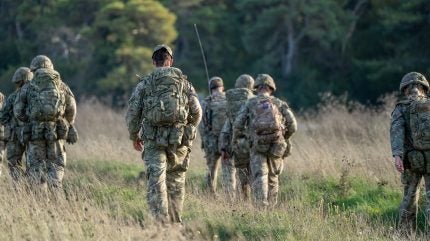
The British Army will start 2025 with a false dawn as it contributes thousands of troops to Nato’s Exercise Steadfast Dart, a deployment that also serves to highlight a bleak future for a service – like its Royal Navy cousin – no longer able to undertake full spectrum warfighting operations.
Due to take place from 8 January – 26 February in Romania and Bulgaria, the former of which borders Ukraine, Exercise Steadfast Dart sees the deployment of Nato’s Allied Reaction Force (ARF), in what is a clear military message to Russia.

Access deeper industry intelligence
Experience unmatched clarity with a single platform that combines unique data, AI, and human expertise.
Announcing the deployment on 3 January, the UK government said it would send over 2,600 troops and some 730 vehicles, specifically stating the Foxhound and Jackal platforms. In addition, the UK’s 1st Division will be in command of Nato’s land forces in the exercise, which also has an airborne and naval element.
A Nato spokesperson confirmed to Army Technology that land contributions would see more than 1,500 military vehicles including main battle tanks, rocket launchers, self-propelled artillery, infantry fighting vehicles, and armoured personnel carriers participate, along with some 10,000 conventional and special forces troops.
Contributing nations are Bulgaria, France, Greece, Italy, Romania, Slovenia, Spain, Türkiye, and the UK.
There was no mention of any AS90 or Archer 155mm artillery, M270 MLRS, Challenger 2 tanks, Warrior infantry fighting vehicles, or other in-service armoured platforms in the UK government release, indicating that armour and lethality could instead come from Nato’s other European members.

US Tariffs are shifting - will you react or anticipate?
Don’t let policy changes catch you off guard. Stay proactive with real-time data and expert analysis.
By GlobalDataAt the time of publishing, the UK MoD had not responded to request for clarification as to whether any UK armoured or indirect fires elements would participate in Steadfast Dart.
A re-ordered and reduced British Army
Shedding its tanks and heavy armour operated when organised as 1 UK Armoured Division in the 2010s, the 1st (UK) Division stepped up to lead the land component of Nato’s ARF in July 2024, tasked with deployment on the core tasks of “non-combatant evacuation operations, humanitarian and disaster relief, and enhanced vigilance activities”, according to British Army information.
The 1st (UK) Division comprises: 16 Air Assault Brigade Combat Team, 4th Light Brigade Combat Team.
7th Light Mechanised Brigade Combat Team; as well as attached logistics, headquarters, signals, and military intelligence units.
As such, any heavy warfighting capability the ARF would have to undertake, such as being seen in fighting between Ukraine and Russia, would require contributions from European Nato allies, as seen in the apparent composition of forces for Steadfast Dart.
The British Army is at one of its lowest ebbs in its history, as ageing vehicles are retired and replacement platforms delayed into service, while the outflow of personnel leading UK Defence Secretary John Healey in October 2024 to state that it would fall to under 70,000 troops.
According to information heard in a defence session in the UK House of Commons on 6 January 2025, during 2023 a total of 15,000 personnel left the UK Armed Forces while only 11,000 new recruits joined.
The vast majority of the British Army’s AS90 155mm artillery has been donated to Ukraine, which is also losing its Warrior infantry fighting vehicles. New or replacement platforms, such the Boxer mechanised infantry vehicle, Ajax infantry fighting vehicles, and RCH 155 artillery have either been or run the risk of a delayed entry into service, or else several years away from introduction.
Valuable reconnaissance platforms such as the Scimitar light tank have also been axed.
In addition, just 148 of the British Army’s approximate 200 Challenger 2s will be upgraded to the Challenger 3 variant, a number that could drop in amid ongoing cuts to key capabilities in the UK military.
British Army has to accept new place in Nato hierarchy
The role of the UK’s lead of Nato’s ARF is critical, and an example of the standard of organisational and infantry capabilities of the British Army. However, the contribution of 1st (UK) Division is perhaps reflective of where the service is at, able only to plug into Nato structures, and potentially confirming its suspected inability to field a full warfighting division into Europe.
In recent months Nato allies have repeatedly, both in public and private, called into question the UK’s boasted claim as being Europe’s premier military power. Most recently, it lack of investment in air defence has been queried, as investigations finds the UK lacking virtually any land-based capabilities.
Meanwhile, countries such as France and Poland have committed significant resources into developing their land forces.
The UK’s new Labour government has made repeated statements to the primacy of Nato and European cooperation for its military, indicative of a preference towards multinationalism and a reduced need for full spectrum capability.
It is possible that contributions to Nato exercises as seen in Steadfast Dart is as good as it is going to get for the British Army until the 2030s as new platforms come online, or else serve as a periodic bright point for a service in terminal decline.


